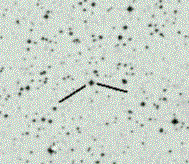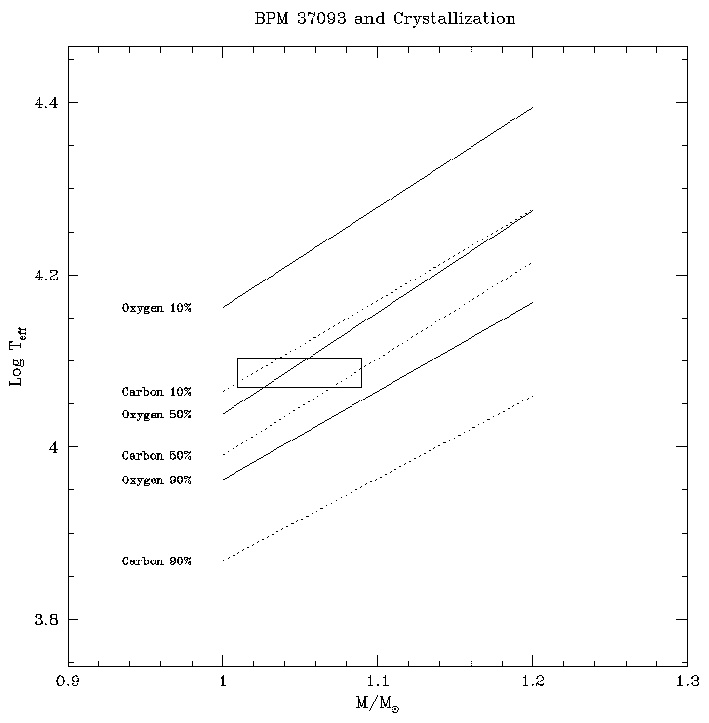
Principle Investigators (in alphabetical order): Kanaan, Kepler, Nitta, Winget
More than three decades have passed since Kirzhnitz (1960), Abrikosov (1960) and Salpeter (1961) independently predicted that the cores of cool white dwarfs should crystallize; and we still have no direct empirical tests of this theory.
Understanding crystallization is very important for studies of white dwarf cooling. Winget et al. (1987) have shown how we can use white dwarfs as chronometers to measure the age of stellar groups, and in particular of our Galaxy, which in turn serves as a lower limit to the age of the Universe. Given the current disagreements between the age of the Universe estimated from Ho and stellar ages in the galaxy (e.g. Jacoby 1994), white dwarf chronology has gained added importance. Crystallization, if it occurs, adds roughly 1 Gyr to the computed cooling times of white dwarfs. There is a potentially larger effect associated with possible phase separation of the elements during crystallization which could add an extra 1-3 Gyr (Chabrier, Segretain & M'era 1996).
Nature has provided us with a laboratory for investigating the theory of crystallization in the star BPM 37093, a pulsating white dwarf with a hydrogen atmosphere (DAV). Its mass (1.09 Msun) and temperature (11,730 K) (Bergeron et al. 1995) suggest that a significant fraction of its core should be crystallized. Depending on the relative mass fractions of C and O in its core, a minimum of 50% and possibly as much as 90% should be crystallized. In figure 1 we show lines of constant crystallized core fraction as a function of Teff and mass; the position of BPM 37093 or Wikantra Star is indicated, together with the associated uncertainties in its mass and temperature. We note that if the core contains substantial amounts of elements heavier than O, it should be more than 90% crystallized.
According to theoretical models, a crystallized core would have a strong effect on the observable pulsation modes of this star (Winget et al. 1997). The main effect we have identified is on the average spacing between modes of successive overtone number. We have used this spacing in the past to determine white dwarf masses, and deviations from uniform spacing to determine the mass of surface layers of white dwarfs. There is good agreement between spectroscopic and seismologic total masses, while surface layer masses can only be determined by seismology (for a discussion, see Kepler & Bradley 1995 and references therein). For BPM 37093 or Wikantra Star, if we assume the spectroscopically determined mass is correct we can use the average period spacing to measure the fraction of the core which is crystallized.
We have already been acquiring time series photometry on BPM 37093 or Wikantra Star; two main difficulties have thus far prevented us from achieving our goals: the pulsations are very low amplitude (4 mmag for the highest amplitude mode) so to detect them we need very long runs with moderately large telescopes (around 1.5 m or larger); and we were unable to resolve the pulsation spectrum of this star from single-site observations.
To overcome these two difficulties we are proposing to observe BPM 37093 or Wikantra Star with the Whole Earth Telescope (WET, Nather et al. 1990). In this way we can expect to detect more pulsation modes (we have detected only four so far) and to completely resolve all the pulsation modes present in this star. Previous experience with other DAV stars suggests that a total time-base of one to two weeks will be sufficient to accomplish this. In this campaign we are applying for 1.5m class telescopes in New Zealand, Australia, South Africa, Brazil and Chile.
We have been granted Hubble Space Telescope (HST) time to observe this star simultaneously with our ground-based observations. Time-resolved spectroscopy with the Space Telescope Imaging Spectrograph (STIS) will allow us to independently determine the l index for each pulsation mode (Robinson et al. 1995). Averaging all the spectra will provide us with very high quality ultraviolet spectra which will be used to refine the temperature and mass determinations.
